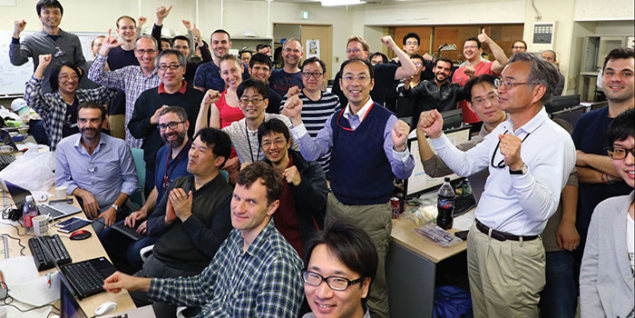
On 26 April the SuperKEKB accelerator at the KEK laboratory in Japan collided its first beams of electrons and positrons, marking the start of an ambitious data-taking campaign that will allow ultraprecise measurements of Standard Model (SM) parameters.
These are the first particle collisions at KEK in eight years, following the closure in 2010 of the KEKB machine to prepare for its next phase. Many subsystems of the accelerator had to be upgraded, the most important involving the use of nanobeam technology to squeeze the vertical beam size at the interaction point to around 50 nm – 20 times smaller than it was at KEKB. This required a complicated system of superconducting final-focus magnets and low-emittance beams (CERN Courier September 2016 p32).
SuperKEKB will work at the so-called intensity frontier to produce copious amounts of B and D mesons and τ leptons, enabling precise measurements of rare decays that test the SM with unprecedented sensitivity. Since the first beams were stored over a month ago, KEK teams have worked to tune the two beams for first collisions at the centre of the Belle II detector – the “super-B factory” upgrade of its predecessor, Belle. When fully commissioned, Belle II will detect and reconstruct events at the much higher rates provided by the 40-fold higher design luminosity of SuperKEKB compared to KEKB. The Belle II outer detector is already in place, but the full inner detector will not be installed until the end of the year, and the first physics run with the complete detector is projected to start in February 2019.

In 2009 KEKB achieved a record instantaneous luminosity of 2.1 × 1034 cm–2 s–1, but SuperKEKB is targeting 8 × 1035 cm–2 s–1. The huge increase is projected to deliver to Belle II a dataset of about 50 billion BB meson pairs – 50 times larger than the entire data sample of the KEKB/Belle project – in about 10 years of operation.
According to Belle II spokesperson Tom Browder, it is not realistic to expect design luminosity straight away. “There will be a number of steps as the beam is progressively squeezed to smaller and smaller sizes, and we fight through each new technical challenge with nanobeams,” he explains. “Our luminosity profile assumes that we progressively resolve these problems at the same rate as KEKB or PEP-II [at SLAC]. In this sense, our programme resembles that of the LHC.”
Belle II has physics goals related to those of the LHCb experiment (CERN Courier April 2018 p23), set against the relatively cleaner environment of electron–positron collisions but with a lower production rate of heavy hadrons with respect to the LHC collisions. Examples include investigating whether there are new CP-violating phases in the quark sector, whether there are sources of lepton-flavour violation (LFV) beyond the SM, whether there is a dark sector of particle physics at the same mass scale as ordinary matter, and whether there are flavour-changing neutral currents beyond the SM. Browder says the Belle II collaboration expects to work on all of the goals, especially on LFV studies, and to catch up with LHCb on certain measurements as soon as a significant amount of luminosity is achieved. “Even with the very early data samples, the team should be able to have impactful results on the dark sector and new hadrons,” he says.








